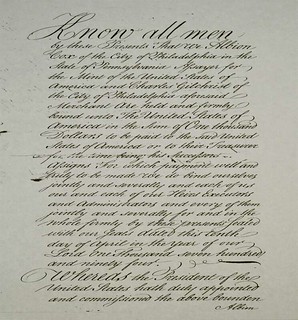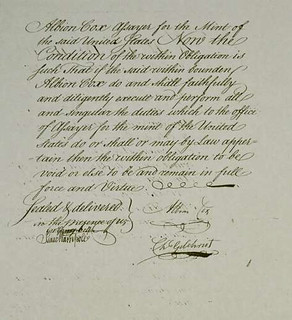
PREV ARTICLE
NEXT ARTICLE
FULL ISSUE
PREV FULL ISSUE
ALBION COX’S SURETY BOND
David Finkelstein submitted this article on Albion Cox’s Surety Bond. Thanks! These bonds are an interesting sidelight and view into the
workings of the early U.S. Mint. -Editor
The general belief, without any supporting evidence, has long been that Charles Gilchrist (a Philadelphia merchant) posted the surety bond for Albion Cox (the first Assayer of the Mint). The earliest printed statement that I have located that names Gilchrist as Cox’s surety is on page 90 of Frank Stewart’s 1924 publication entitled “History of the First United States Mint: Its People and Its Operations”: “The shortage of $974.75 was charged to mismanagement of Albion Cox due to a quantity of silver becoming mixed with ashes and broken crucibles. Charles Gilchrist, after the death of Cox, presented a bill against the Mint which was rejected by the Director, who wrote Alexander Dallas November 14, 1797, that he feared that Gilchrist, who was security for Cox, might be found a considerable debtor because of the above mentioned shortage”. I can now confirm that Charles Gilchrist did in fact post Albion Cox’s surety bond. Cox’s surety bond has been found, stored among Treasury Department documents for the last 221 years. It is presented in this article for the first time ever. The Mint & Coinage Act of April 2, 1792 required the Assayer to be bound to the United States of America and to post a surety bond of $10,000.00. This sum was too large for Cox, as he was unable to obtain someone to guarantee his bond. This issue was one of the impediments to converting silver and gold bullion into coins during 1793 and most of 1794. Without the bond in place, Cox was unable to assay silver and gold bullion, and the value of a bullion deposit, in United States money, could not be determined. On December 30, 1793, Secretary of State Thomas Jefferson wrote a two page letter to President Washington identifying issues with The Mint & Coinage Act that prevented the Mint from accepting bullion deposits, and striking silver and gold coins. Per the first sentence, Jefferson’s letter was based on information provided by Director of the Mint David Rittenhouse:
“I am informed, by the Director of the Mint, that an impediment has arisen to the coinage of the precious Metals, which it is my Duty to
lay before you”.
Jefferson’s letter also included the following passages: “It will be recollected… That thereupon, our minister at London, according to the instructions he had received, endeavored to procure, there, a Chief Coiner and Assayer; That, as to the latter, he succeeded, sending over a Mr Albion Coxe, for that Office, but that he could procure no person, there, more qualified to discharge the duties of chief Coiner, than might be had here; and therefore did not engage one. The Duties of this last Office, have consequently been hitherto performed, and well performed by Henry Voight, an Artist of the United States: but the law requiring these Officers to give a security in the sum of 10,000 dollars each, neither is able to do it”. “… The other alternative would be to lessen the Securityship in money, and to confide that it will be supplied by the vigilance of the Director, …” Note that in 11 letters written by Thomas Jefferson, he referred to the Assayer 6 times as Albion Coxe and 5 times as Albion Cox. We now know, per the surety bond, that he was in fact Albion Cox, and not Albion Coxe. On December 31, 1793, President Washington forwarded Jefferson’s letter to Congress. On February 18, 1794 the Senate passed a bill entitled "an act in alteration of the act establishing a mint and regulating the coins of the United States” or The Alteration of the Mint Act. The bill was approved by the House of Representatives on February 25th and signed into law by President Washington on March 3, 1794. Per Section 2 of The Alteration of the Mint Act, the Assayer’s surety bond was reduced from $10,000.00 to $1,000.00: “And be it further enacted, That the assayer and chief coiner of the mint previous to entering upon the execution of their respective offices shall each become bound to the United States of America with one or more sureties to the satisfaction of the Secretary of the Treasury, the said assayer in the sum of one thousand dollars and the said chief coiner in the sum of five thousand dollars, …“  
Due to the vigilance of David Rittenhouse, Albion Cox’s surety bond was posted on April 10, 1794 by Charles Gilchrist. Note that a surety bond was and still is a contract between a minimum of three parties: 1. the principal - the party who will perform a contractual obligation (Albion Cox), 2. the obligee - the party who is the recipient of the contractual obligation (the United States of America), and 3. the surety – the party who assures to the obligee that the principal can perform the contractual obligation (Charles Gilchrist). If the principal (Cox) was unable to perform his duties, the obligee (the United States of America) could have sued the surety (Gilchrist) for damages up to the full amount of the bond. For more information on Albion Cox, please read Nancy Oliver’s & Richard Kelly’s excellent article entitled “The Life of Albion Cox” that was published in the September, 2013 issue of The Numismatist. Wayne Homren, Editor The Numismatic Bibliomania Society is a non-profit organization promoting numismatic literature. See our web site at coinbooks.org. To submit items for publication in The E-Sylum, write to the Editor at this address: whomren@gmail.com To subscribe go to: https://my.binhost.com/lists/listinfo/esylum All Rights Reserved. NBS Home Page Contact the NBS webmaster 
|